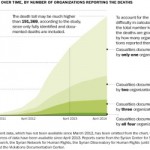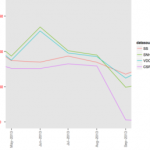2014 Press room
Here is a collection of press coverage of the Human Rights Data Analysis Group.
Back to the Press RoomIn Syria, Uncovering the Truth Behind a Number

Huffington Post Politics writer Matt Easton interviews Patrick Ball, executive director of HRDAG, about the latest enumeration of killings in Syria. As selection bias is increasing, it becomes harder to see it: we have the “appearance of perfect knowledge, when in fact the shape of that knowledge has not changed that much,” says Patrick. “Technology is not a substitute for science.”
Read full article off-siteWhy It Took So Long To Update the U.N.-Sponsored Syria Death Count

In this story, Carl Bialik of FiveThirtyEight interviews HRDAG executive director Patrick Ball about the process of de-duplication, integration of databases, and machine-learning in the recent enumeration of reported casualties in Syria.
New reports of old deaths come in all the time, Ball said, making it tough to maintain a database. The duplicate-removal process means “it’s a lot like redoing the whole project each time,” he said.
SermonNew death toll estimated in Syrian civil war

Kevin Uhrmacher of the Washington Post prepared a graph that illustrates reported deaths over time, by number of organizations reporting the deaths.
Read full article off-siteUN Raises Estimate of Dead in Syrian Conflict to 191,000

Nick Cumming-Bruce of the New York Times writes about the UN Office of the High Commissioner of Human Right’s release of HRDAG’s third report on reported killings in the Syrian conflict.
From the article:
In its third report on Syria commissioned by the United Nations, the Human Rights Data Analysis Group identified 191,369 deaths from the start of the conflict in March 2011 to April 2014, more than double the 92,901 deaths cited in their last report, which covered the first two years of the conflict.
“Tragically, it is probably an underestimate of the real total number of people killed during the first three years of this murderous conflict,” Ms. Pillay said in a statement that accompanied the report, which observed that many killings in Syria were undocumented.
New UN report counts 191,369 Syrian-war deaths — but the truth is probably much, much worse

Amanda Taub of Vox has interviewed HRDAG executive director about the UN Office of the High Commissioner of Human Right’s release of HRDAG’s third report on reported killings in the Syrian conflict.
From the article:
Patrick Ball, Executive Director of the Human Rights Data Analysis Group and one of the report’s authors, explained to me that this new report is not a statistical estimate of the number of people killed in the conflict so far. Rather, it’s an actual list of specific victims who have been identified by name, date, and location of death. (The report only tracked violent killings, not “excess mortality” deaths from from disease or hunger that the conflict is causing indirectly.)
Syrian civil war death toll exceeds 190,000, U.N. reports

Ayan Sheikh of PBS News Hour reports on the UN Office of the High Commissioner of Human Right’s release of HRDAG’s third report on reported killings in the Syrian conflict.
From the article:
The latest death toll figure covers the period from March 2011 to April of this year, came from the Human Rights Data Analysis Group and is the third study of its kind on Syria. The analysis group identified 191,269 deaths. Data was collected from five different sources to exclude inaccuracies and repetitions.
Why Collecting Data In Conflict Zones Is Invaluable—And Nearly Impossible

R programming language demands the right use case

Megan Price, director of research, is quoted in this story about the R programming language. “Serious data analysis is not something you’re going to do using a mouse and drop-down boxes,” said HRDAG’s director of research Megan Price. “It’s the kind of thing you’re going to do getting close to the data, getting close to the code and writing some of it yourself.”
Read full article off-siteHow statistics lifts the fog of war in Syria

Megan Price, director of research, is quoted from her Strata talk, regarding how to handle multiple data sources in conflicts such as the one in Syria. From the blogpost:
“The true number of casualties in conflicts like the Syrian war seems unknowable, but the mission of the Human Rights Data Analysis Group (HRDAG) is to make sense of such information, clouded as it is by the fog of war. They do this not by nominating one source of information as the “best”, but instead with statistical modeling of the differences between sources.”
Using Data and Statistics to Bring Down Dictators

In this story, Guerrini discusses the impact of HRDAG’s work in Guatemala, especially the trials of General José Efraín Ríos Montt and Colonel Héctor Bol de la Cruz, as well as work in El Salvador, Syria, Kosovo, and Timor-Leste. Multiple systems estimation and the perils of using raw data to draw conclusions are also addressed.
Megan Price and Patrick Ball are quoted, especially in regard to how to use raw data.
“From our perspective,” Price says, “the solution to that is both to stay very close to the data, to be very conservative in your interpretation of it and to be very clear about where the data came from, how it was collected, what its limitations might be, and to a certain extent to be skeptical about it, to ask yourself questions like, ‘What is missing from this data?’ and ‘How might that missing information change these conclusions that I’m trying to draw?’”
Nonprofits Are Taking a Wide-Eyed Look at What Data Could Do

In this story about how data are transforming the nonprofit world, Patrick Ball is quoted. Here’s an excerpt: “Data can have a profound impact on certain problems, but nonprofits are kidding themselves if they think the data techniques used by corporations can be applied wholesale to social problems,” says Patrick Ball, head of the nonprofit Human Rights Data Analysis Group.
Companies, he says, maintain complete data sets. A business knows every product it made last year, when it sold, and to whom. Charities, he says, are a different story.
“If you’re looking at poverty or trafficking or homicide, we don’t have all the data, and we’re not going to,” he says. “That’s why these amazing techniques that the industry people have are great in industry, but they don’t actually generalize to our space very well.”
Big Data Predictive Analytics Comes to Academic and Nonprofit Institutions to Fuel Innovation

“Revolution Analytics will allow HRDAG to handle bigger data sets and leverage the power of R to accomplish this goal and uncover the truth.” Director of Research Megan Price is quoted
Read full article off-siteDeath March

A mapped representation of the scale and spread of killings in Syria. HRDAG’s director of research, Megan Price, is quoted.
Read full article off-site